In this blog, we will guide you through the entire process of how to start a travel blog, from selecting a travel niche, picking a blogging platform, naming your blog to design your website, and creating compelling and search-optimized content. We will also review how to make money with your travel blog using effective monetization tactics. Ready? Let’s get started!
70% of people use search engines for general web searches to plan their travel.
The travel industry is one of the largest service industries in the world with many subsets and sectors such as transportation, accommodations, food and beverages, entertainment, etc. The travel industry is growing at an annual rate of 4.4% and is projected to pass the US$1BN mark in market value by 2027.
With Covid-19, the industry took a major hit but quickly bounced back to thrive again.
So if you’re passionate about traveling and love sharing your experiences with others, starting a travel blog may be the perfect hobby to turn into a profitable business in 2025.
Why Start a Travel Blog?
First, it is important for you to define what type of blogger you are and plan to be, and what motivates you to start your travel blog. There are three types of travel bloggers who start travel blogging;
- Hobbyist Travel Bloggers: they are passionate about travel hacks, tips, trips, and local experiences. They blog about their passion and hobby. They are looking to take the next step to become a part-time or full-time travel blogger. Blogging as a business is new territory to them.
- Side Hustle or Part-Time Travel Bloggers – They plan to keep their full-time work but want to dedicate time to developing their travel blog and sharing their experience.
- Full-Time Travel Bloggers – whether they are planning their next trips or restaurant reviews, travel blogging is their primary source of income and full-time activity, and they would like to take the next steps into scaling this activity.
Once you’ve identified what type of travel blogger you are or plan to be, let’s review why starting a blog can contribute to expanding your professional career and network with thought leaders and bloggers in that space. We will also discuss how it can help you build a community, develop an audience, attract new clients, and monetize your blog.
Expand your Resume and Experience
Whether you are doing that as a side hustle or because you are a travel enthusiast always seeking new experiences to share, travel blogging is a great way to combine two passions: traveling and writing. It involves sharing experiences and insights from your trips with a wider audience through blog posts, photos, and videos.
If you have experience in travel blogging, it can demonstrate your experience and skills in writing, researching, and storytelling. It can also show that you have a keen interest in different cultures, languages, and traditions. Furthermore, travel blogging requires creativity, time management, and technical skills in website management and social media promotion.
When including your travel blog experience in your resume, you can describe the type of content you create such as destination guides, travel stories, and photography. You can also talk about your audience and any collaborations you’ve done with other travel brands or influencers, etc.
You’d be amazed by all the skills, responsibility, and experience you can get out of your travel blog and this experience can be a valuable asset to your resume, as it demonstrates your writing, research, website management, social media promotion, technical skills, as well as your passion for travel and cultural exchange.
Build a Community and Attract New Clients
The travel community is one of the largest communities in the blogging sphere.
There are countless forums, travel events, trade shows, and conferences to connect with other travel bloggers, brands, and tourism boards. By being part of a community, bloggers can share ideas, gain new perspectives, and expand their reach in the travel industry.
Knowing where to hang out to get relevant information about your potential audiences and to share experiences with other bloggers in that space is essential.
Check out the global network of travel industry professionals, including bloggers, tour operators, and destination marketers such as Travel Massive, Lonely Planet Pathfinders, International Travel Writers Alliance, and Outdoor Blogger Network. These are well-known communities of travel bloggers and content creators who share their experiences and perspectives on travel.
Not only can it provide you with inspiration for your travel blog content but it can unfold many opportunities to reach and expand your audience and attract new clients and business opportunities.
Make Money
Clear. Plain. Simple.
If you decide to start a travel blog, making money is certainly an essential factor in your decision. Travel bloggers can live off their passion and even generate passive income with their travel blogs. As you build and expand your audience, community, and blogging skills, you will unlock many opportunities to turn your passion for travels or for blogging into a profitable business.
Successful Travel Blog Examples
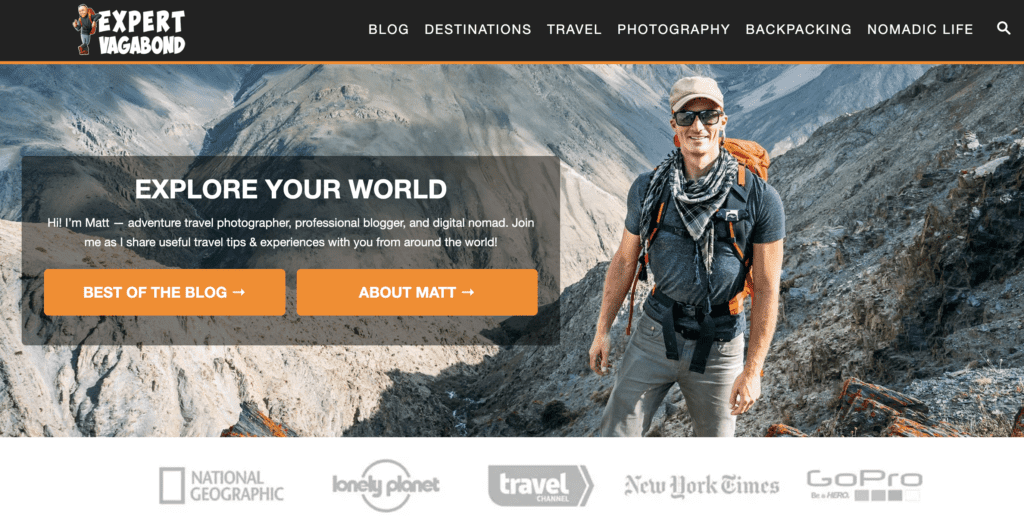
Adventure travel photographer, professional blogger, and digital nomad. Matt shares his experience via useful travel tips and hacks from all around the world.
ExpertVagabond.com is a travel blog and photography website founded by Matthew Karsten, a professional adventure travel photographer, and blogger. The site offers a variety of content related to travel, outdoor adventure, and photography, including destination guides, travel tips, and photography tutorials.
The blog features stunning photographs and personal travel stories from around the world, with a focus on off-the-beaten-path destinations and immersive cultural experiences. In addition to the blog, ExpertVagabond.com offers photography workshops and sells prints of Matthew’s stunning travel photographs.
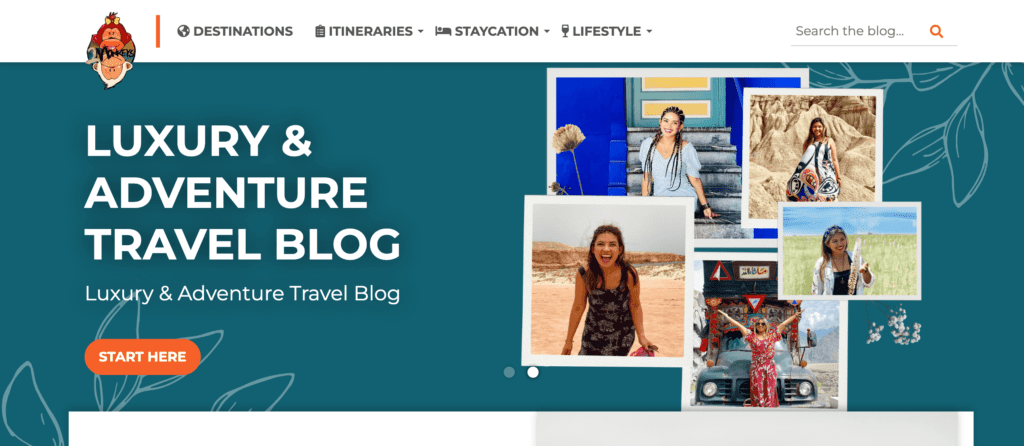
TwoMonkeysTravelGroup.com is a travel and lifestyle website founded by Kach Medina Umandap and Jonathan Howe, a couple who left their corporate jobs to travel the world full-time.
The site offers a wide range of travel-related content, including destination guides, travel tips, and personal travel stories from around the world. The blog features articles on budget travel, adventure travel, luxury travel, and more, with a focus on sustainable and responsible tourism. In addition, to travel content, TwoMonkeysTravelGroup.com also offers lifestyle articles on topics such as digital nomadism, personal development, and relationships.
The site also has a community of like-minded travelers and offers travel-related products and services, such as travel coaching, online courses, and travel gear.
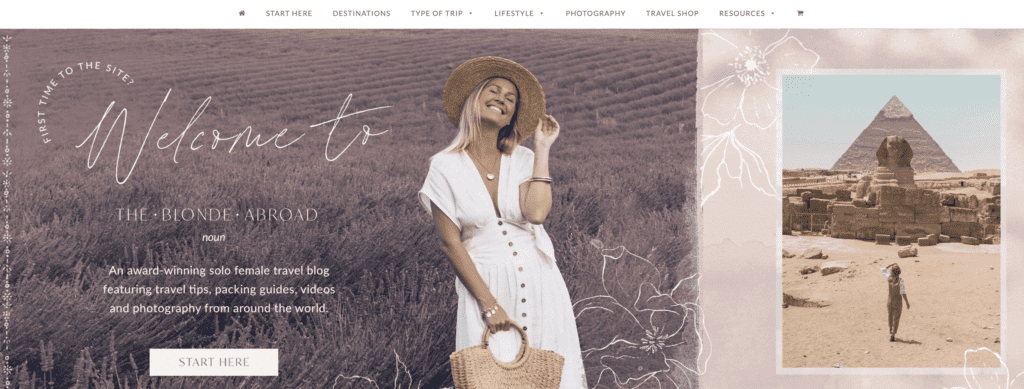
TheBlondeAbroad.com is a travel and lifestyle blog founded by Kiersten Rich, a California native who left her career in corporate finance to travel the world full-time. The site offers a variety of content related to travel, fashion, and beauty, including destination guides, travel tips, and personal travel stories from around the world.
The blog features articles on solo female travel, adventure travel, luxury travel, and more, with a focus on empowering women to travel confidently and safely. In addition, to travel content,
TheBlondeAbroad.com also offers fashion and beauty articles, with a focus on travel-related fashion and beauty tips. The site also has a community of like-minded travelers and offers travel-related products and services, such as travel guides, e-books, and travel photography workshops.
How To Start A Travel Blog In 9 Steps
1- Research and Narrow Down Your Niche
The winning formula when selecting a profitable travel niche is based on 3 factors:
- Passion and Interest
- Audience Budget Potential
- Niche Size and Competition
Our recommendation is to first tap into your expertise in the travel space. If you are a travel enthusiast or have worked in that industry, this is an excellent start to narrow down your list of niches to target for your travel blog. It is always easier to speak about our passion and be committed to any project in the long term.
If you are not an expert yet but know all the ins and outs of building memorable online experiences and digital marketing has no secrets to you, then ask yourself; what value can you build and offer to your potential audience in the travel space?
There are many niche markets to consider in the travel industry. We narrowed down a list of 15 trending travel niches with high earning potential:
- Solo Travelers
- Backpacking
- RV Life
- Travel Deals
- Resorts
- Family Travels
- Adventure Travel
- Gastro-Tourism and Food Travels
- Themed Cruises
- Luxury Travels
- Ethical and Eco-Tourism
- Bleisure Travels (Business + Leisure)
- Wellness Travels
- Spiritual and Travel Retreats
- Best Places to Visit
You can research trends in each of these niche markets using Google Trends or heading to travel communities and networks to hear what is trending.
For example, in the luxury travel space, there are many trends and topics to focus on with high earning potential:
- High-end adventure luxury travels
- Helicopter tours, private yacht charters, and luxury safari trips.
- Exotic destinations such as Bali or Maldives
- High-end spa treatments while traveling
- Glamping
- Luxury train journeys
- Etc.
2- Choose A Domain Name
Choosing a domain name for your travel blog can be both exciting and daunting. It’s like naming your newborn baby – you want it to be unique, catchy, and memorable!
Your domain name is the first impression your audience will have of your brand, so it’s important to get it right. It needs to accurately represent your blog or business while also standing out from the competition. But with so many names already taken, finding the perfect domain name can feel like searching for a needle in a haystack. However, with some creativity and persistence, you can find the perfect name that sets you apart from the rest. À few things to consider:
- Consider your brand: If you plan on building a brand around your travel blog, choose a name that reflects your brand’s values, mission, and identity.
- Brainstorm relevant keywords: As you researched the travel industry for relevant niches, look for relevant keywords and terms you can use for your blog name. Start by brainstorming a list of keywords that are related to the topic of your blog. Consider the topics, themes, and focus of your blog, and make a list of relevant keywords.
- Make it short and memorable: A good domain name or blog name should be short and easy to remember. Keep it simple, and avoid using complex words or phrases that people may not be able to remember or spell. The rule of thumb should maximum of a 3-word name.
- Choose a unique name: Make sure the name you choose is unique and not already taken. You can use domain name generators to come up with unique names.
- Avoid hyphens and numbers: Hyphens and numbers can make it difficult for people to remember your domain name or blog name. Avoid using them if possible.
- Use a .com extension: If possible, choose a domain name with a .com extension. This is the most common extension and is easier for people to remember. We always recommend buying all the most important extensions to make sure your domain name won’t be picked by another brand under another extension such as.co .net etc. Try to secure these extensions as well.
- Check for trademarks: Make sure the name you choose is not already trademarked. You can search the USPTO database to check for existing trademarks.
- Check social media handles and accounts: Check that the name you choose is available to be used for your social media accounts.
- Test it out: Before you make a final decision, test out your domain name or blog name by sharing it with your friends, colleagues, and family. Ask for their feedback and see if it resonates with them.
- Register your domain name: Once you’ve found the perfect name, register it with a domain registrar like GoDaddy or Namecheap. Make sure to renew your domain registration annually to keep it active.
Example of a travel blog in the luxury travel niche. These may not be available names at the time you read this blog.
- PrestigeExplorer
- UltimateJetsetter
- GlamorousGetaways
Remember, your domain name is the foundation of your online presence, and a well-chosen name can help you establish yourself as a leader in your space. So don’t stress too much, let your creativity run wild, and you’re sure to find a name that’s perfect for you!
3 – Setup Your Web Hosting Services
Once you pick a domain name for your blog, it is time to think about choosing a web hosting platform to make your travel blog accessible to the public. Web hosting platforms store your website’s files and data on servers and provide the necessary technologies and infrastructure for your website to be accessed by visitors on the internet.
A web hosting platform typically offers various features such as server management, security, backup and recovery, website builder tools, and customer support. When choosing a web hosting platform, it’s important to consider factors such as reliability, speed, security, and scalability to ensure that your website runs smoothly and effectively. We shortlisted our recommended web hosting providers in the market that can help you set up a fast and reliable website hosting solution.
- Bluehost
- Site Ground
- Cloudways
- LiquidWeb
- Hostinger
- WP Engine
Get started with BlueHost Hosting for your Travel Blog
If you are ready to take that steps, here is a complete step-by-step guide to help you set up your web host with BlueHost in just a few clicks.
Step 1 – Visit BlueHost.com
Click on the “GET STARTED” Call-to-action
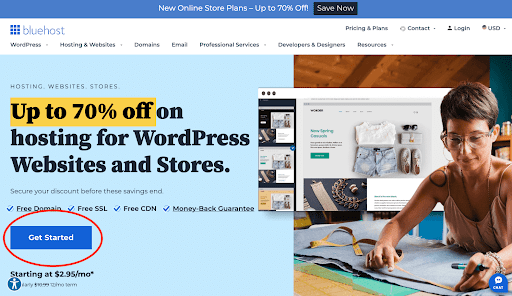
Step 2- Choose your Blog Hosting Plan
Bluehost offers 4 different types of hosting plans for your blog: BASIC, PLUS, CHOICE PLUS, and PRO. You can start your blog with the BASIC plan which offers good features at an affordable price. We recommend the CHOICE PLUS plan for several reasons:
- Domain Privacy & Protection – This feature protects your personal information and data from being available to the rest of the world such as full name, residential address, phone number, and email address.
- Unlimited Websites and Domain Names – These features give you the opportunity to register more unlimited domain names to the same shared hosting solution. If you have several business ideas for different niches or if you plan to grow and extend new blog verticals, this is the perfect hosting solution.

Step 3 – Setup your domain name
Several options:
- Use a domain you own: If you have a domain name, you can enter it and continue with the next step.
- Create a new domain: If you already have an idea of your domain name you can enter it. Bluehost offers a FREE Domain name for the first year.
- Skip the Step and create a domain name later: if you don’t have a domain name yet, you still have the option to continue setting up your hosting plan.
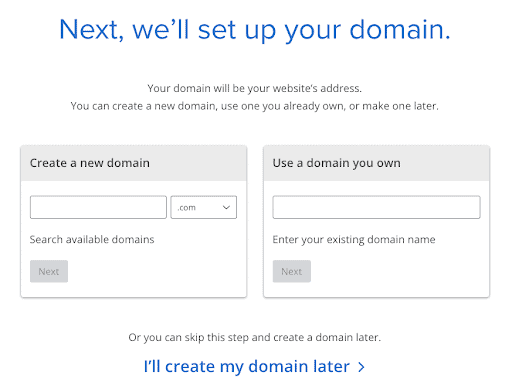
Let’s create a domain later or connect one from another domain registrar.
Step 4. Account Information Details
Enter your account information and ensure the details are accurate. If you selected the CHOICE PLUS hosting solution, your personal information will be confidential and not accessible to the public.

Select your hosting package information for your blog
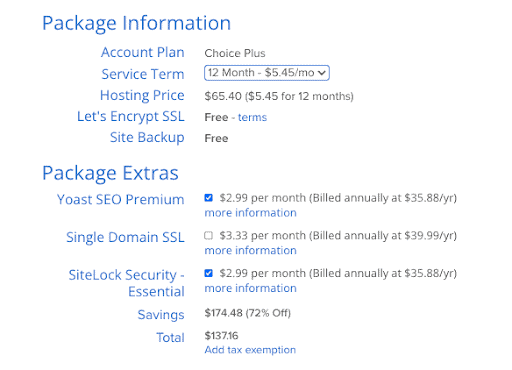
If you are serious about starting a blog and generating money, I recommend selecting the CHOICE PLUS plan. You will save up to 70% and get additional privacy and security features to protect your personal information, and you can connect to an unlimited number of websites.
Bluehost SEO tool offers a user-friendly dashboard to measure your blog health and performance. You can opt for extras options such as the Yoast SEO Premium for only $2.99 per month.
Step 5. Enter your payment information
Finalize your hosting account and choose to pay your web plan by credit card or using PayPal.
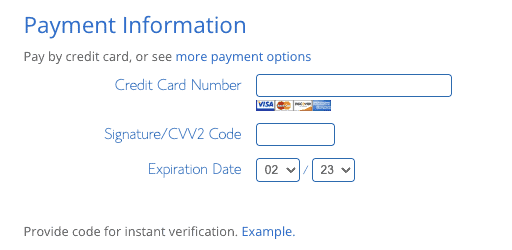
Step 6. Finalize your hosting account plan

Once you have read and agreed to Bluehost policies, you are all set!
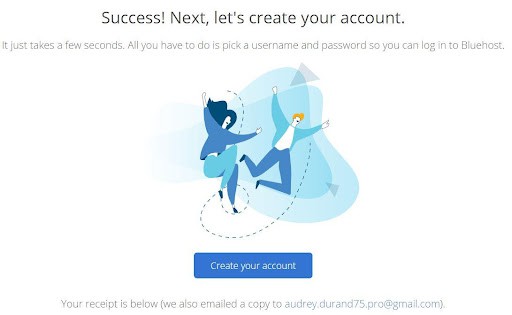
Don’t forget to write down your hosting plan expenses in your startup expenses to keep track of your expenses.
Step 7. Create your account login information
Let’s start by creating a password for your Bluehost Account
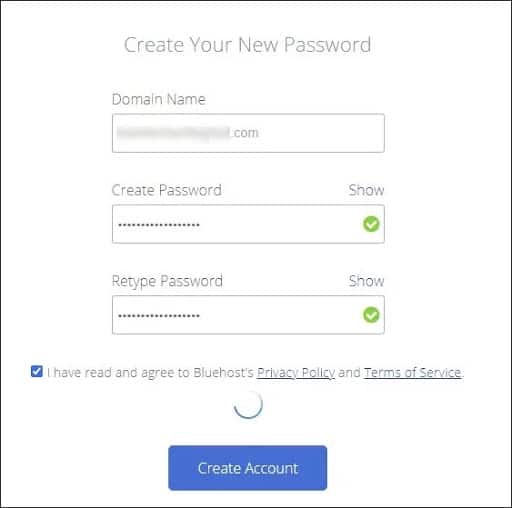
Step 8. Login to your account
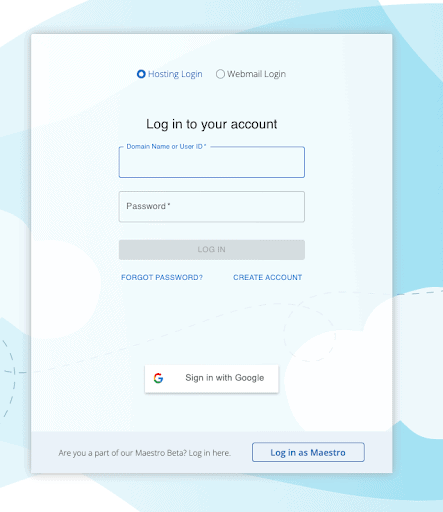
The final step is to enter your Domain Name or User ID and Password and hit ‘Login’. You are all set with registering your blog with Bluehost and logging in to your new account! In the next section, we will review how to choose and set up your blogging platform.
For more details on domain name selection, blogging, and hosting platforms, check out our technical guide to starting a blog
4 – Choose Your Blogging Platform
When it comes to choosing the best blogging platform for travel bloggers, there are a few key factors to consider.
First and foremost, you want a platform that is easy to use and customize, with a variety of templates and design options that will help your blog stand out.
Additionally, you should look for a platform that offers strong SEO capabilities, as this will help your blog rank higher in search engine results and attract more traffic. Other important features to consider include mobile optimization, social media integration, and the ability to monetize your blog through ads or affiliate marketing.
Some popular blogging platforms for travel bloggers include WordPress, Blogger, and Squarespace, but ultimately, the best choice will depend on your specific needs and preferences.
WordPress is often considered one of the best blogging platforms for several reasons. The platform offers a vast library of themes and plugins that allow for easy customization and functionality, which can help your blog stand out and offer a unique user experience. Furthermore, WordPress has a strong community of developers and users, which means there are plenty of resources and support available if you need help or have questions.
WordPress is SEO-friendly, which means it can help your blog rank higher in search engine results and attract more traffic. Overall, WordPress is a powerful and flexible platform that can meet the needs of bloggers of all levels of experience and expertise.
5 – Choose and Customize Your Blog Theme
This is one of the fun parts of setting up your business or blog, selecting and configuring the main structure of your blog. In WordPress, your configuration, choice of layout, fonts, and templates will be mostly powered but the theme you choose so once you’ve chosen an activated WordPresss, select a theme that fits the look and feel you want for your blog.
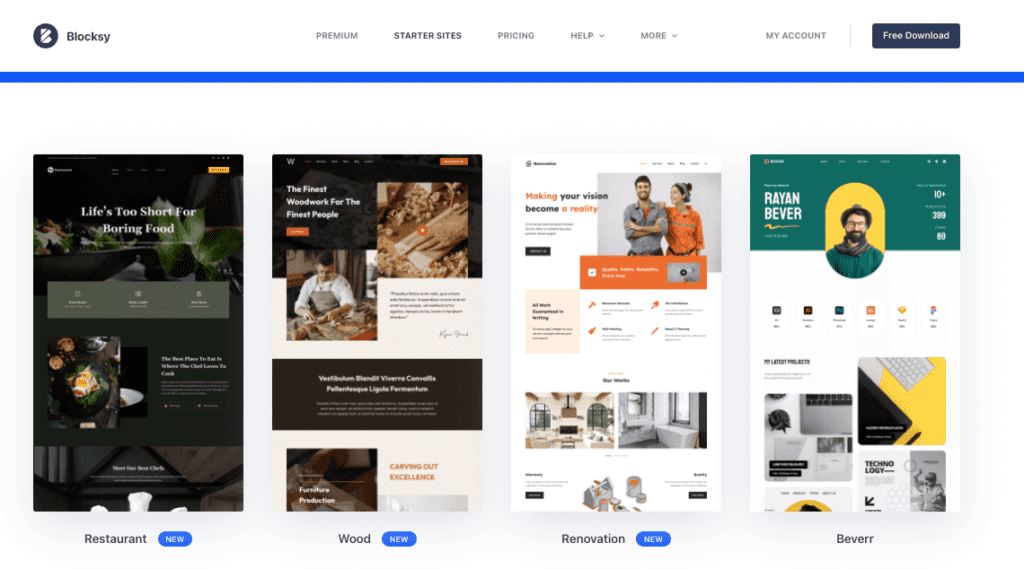
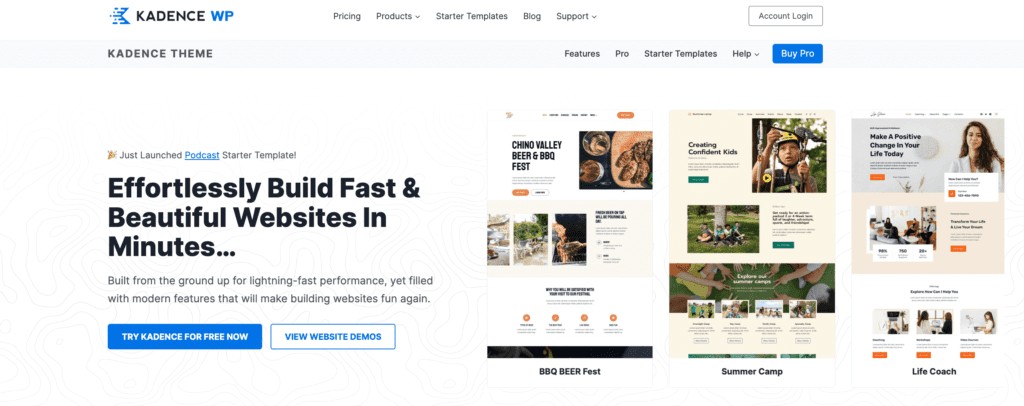
Many themes come with pre-built layouts, color schemes, and font options, but you can also customize these elements to make them unique to your brand.
The first thing visitors see when they land on your page is your header. Make sure to set and configure your header first so it accurately reflects your brand and messaging. You can customize your header image, font, and colors to make it stand out.
Many blog themes offer customizable layouts, allowing you to choose how your content is displayed. You can add widgets, rearrange your sidebar, and adjust your post layout to create a unique look. We recommend keeping it simple and easy to navigate for your audience.
If you have coding skills, you can add custom CSS to your theme to make more advanced changes. This allows you to customize your blog even further.
Once you are done configuring your themes, it is time to set your fonts and color scheme for the entire experience of your site.
6 – Choose Your Design & Branding Palette
Fonts, design, and colors are essential parts and components of your travel blog branding. Select a font that is easy to read and complements your blog’s style and tone. If you already pick the font for your blog, you can start customizing your theme and templates with your font and styles.
For colors, choose a color scheme that reflects your brand and creates a cohesive look across your blog. Consider using a tool like Adobe Color or Canva to create a custom color palette.

Canva offers a wide range of font options that you can use for your travel blog. You can browse through the available fonts and choose the ones that best match your blog’s style and personality. Canva also allows you to upload your own custom fonts if you have a specific font in mind that’s not available in their library.
Canva has a feature called “Color Palette Generator” that allows you to generate a color palette based on an image. This is a useful tool if you have a specific image or travel photography that you want to use as a reference for your travel blog’s color scheme. You can also create your own color palette by selecting colors from Canva’s color wheel or by entering specific color codes.
Canva also offers a variety of design templates that you can use as a starting point for your blog’s design. These templates already have a set color scheme and font selection, so you can use them as a reference or customize them to your liking.
7 – Create Essential Key Pages
As you get close to launching your blog, there is an essential page to create and publish first. It is an important step in building your professional blog website;
- Home Page: Your home page is the first page visitors see when they land on your site. It should provide an overview of your blog and what visitors can expect to find on your website. Consider using a clear and concise headline, a short introduction, and links to your most popular posts.
- About Page: Your About page is where you can introduce yourself and your brand. Use this page to tell your story, share your values, and give visitors a sense of who you are and what your blog is all about.
- Contact Page: Your Contact page should make it easy for visitors to get in touch with you. Include a contact form, your email address, and links to your social media profiles.
- Blog Page: Your Blog page is where visitors can browse through all of your posts. Make sure it’s easy to navigate and includes categories, tags, and a search bar to help visitors find the content they’re looking for.
- Privacy Policy Page: A Privacy Policy page is required by law in many countries. It explains how you collect, use, and protect personal data from your visitors. You can create one using a privacy policy generator tool.
- Terms and Conditions Page: Your Terms and Conditions page outlines the rules and guidelines that visitors must follow when using your website. This can include copyright information, disclaimer notices, and other legal requirements.
By creating these essential pages, you’ll be able to provide visitors with a clear and informative overview of your blog while also ensuring that your website is legally compliant.
8 – Start Creating Content
Once you have your core pages ready to be published, it is time to give life to your travel blog with the most important part to be a successful business: creating content
To start the content creation process, the first step is to get into keyword research to find opportunities to write fresh and relevant content for your audience.
Keyword Research – We recommend focusing on keywords with at least 1,000 monthly searches.
If you are planning to focus on luxury travels or adventures, below are examples of topical keywords to focus your content on. You can use tools such as Google Keyword Planner or Ahrefs to help get access to keyword difficulty, and search volume and analyze how your main competitors are performing.
| Adventure Luxury Travel | LSI Keywords | Average Monthly Search Volume |
|---|---|---|
| Helicopter Tour | Private helicopter rides, scenic aerial tours, VIP helicopter experiences, luxury helicopter charters, helicopter adventure trips | 1,600 |
| Private Yacht Charters | Luxury yacht rentals, exclusive boat tours, personalized yacht vacations, high-end yacht cruises, private sailboat charters | 2,400 |
| Luxury Safari Trips | VIP wildlife tours, upscale safari adventures, luxury camping safaris, private safari expeditions, high-end game drives | 1,900 |
| Exotic Destinations | Tropical paradise vacations, luxury island getaways, secluded beach holidays, exclusive resort destinations, high-end travel destinations | 3,600 |
| High-End Spa Treatments | Luxury wellness retreats, pampering spa experiences, exclusive spa packages, top-rated spa resorts, high-end beauty treatments | 2,100 |
| Glamping | Luxury camping experiences, high-end safari tents, deluxe outdoor accommodations, upscale camping resorts, glamorous camping trips | 1,000 |
| Luxury Train Journeys | Deluxe rail tours, high-end train travel, luxury sleeper trains, upscale railway experiences, premium train trips | 1,800 |
For each focus keyword, you can create topical clusters with LSI keywords and write a blog post about the topic. This will not only help boost overall page impressions and traffic to your travel site but also help boost the rankings of your main focus keywords.

Create an Internal Links Plan – Organizing your content into categories as in the previous example and creating a hierarchical structure for your travel blog can help guide users and search engines to important pages on the website.
Internal linking is a crucial component of your blog’s SEO strategy and it should be implemented thoughtfully and strategically. When done correctly, it can improve user experience, boost your rankings, and help distribute link equity throughout your travel blog.
Use descriptive anchor text, linking to relevant and related content, avoid excessive linking, and ensure that the links are accessible and crawlable by search engines.
Create a Content Schedule – This is another essential step in building a successful travel blog. Make sure to create high-quality content that engages your readers.
- Define your goals – for example, write 5 blogs per month that cover luxury expeditions and trips to Bali
- Plan ahead – at least 90 days ahead is optimal.
- Determine your posting frequency
- Research and brainstorm content ideas on a regular basis
- Stay flexible – be open to changing your content schedule if needed. Life happens, and sometimes you may need to adjust your schedule to accommodate unexpected events or changes in your industry
Create a schedule that outlines the topic, title, due date, and publishing date for each blog post. This will help you stay on track and ensure that your blog stays up to date.
Congratulations on making it up to that step! In the final sections of this blog, we will review how to promote your content, grow and monetize your audience, and take a final look at the budget and cost for starting and managing your blog. Starting a travel blog does not have to be expensive!
But first, let’s review how to promote your travel blog and how to monetize it.
9 – Promote Your Blog & Grow Your Audience
Now that you have a blog up and running, it is time to plan for promoting it by implementing a promotion strategy that will increase your blog’s visibility and attract more readers. Remember to be consistent, provide value to your audience, and engage with your followers to build a loyal community around your blog.
- Optimize for SEO: You’ve done it so far, there are no reasons to stop optimizing your blog content with SEO best practices. Make sure to research and implement relevant keywords in your titles, content, and meta descriptions, and always write for your audience first. Remember 70% of your audience is searching online. Put all your chance to boost impressions and clicks to your site by creating content with SEO best practices.
- Use social media: Promote your blog on social media platforms like Facebook, Twitter, Instagram, and Pinterest. Most of the free traffic sources you can use to drive to your blog is coming from social media and forums. Share your blog posts with your followers and engage with them by responding to comments and messages.
35% of people find new travel destinations on Instagram
- Guest post on other travel blogs: Reach out to other travel bloggers and offer to guest post on their sites. This can help you reach a new audience and gain backlinks to your own blog.
- Participate in online travel communities: Join travel groups on Facebook, Reddit, and other online forums. Share your blog posts with the community and engage with other members by answering questions and providing valuable insights.
- Collaborate with other bloggers: Collaborate with other travel bloggers to create joint content or host a giveaway. This can help you reach a wider audience and build relationships with other bloggers in your niche.
- Attend travel events: Attend travel events like conferences, meetups, and workshops. These events can help you connect with other bloggers and industry professionals and promote your blog.
- Create an email newsletter to promote your blog and keep your readers engaged, and build a loyal audience of travel enthusiasts. As with your blog content, always keep in mind to provide valuable content and regularly engage with your audience.
Check out the best email marketing services for travel bloggers and entrepreneurs to get you quickly up and running with your newsletter.
Make Money with Your Travel Blog
Promoting your travel blog will help you build traffic and visibility online. The more visibility your blog can acquire from page impressions or social and referral traffic, the better the timing to start monetizing your content. Here are some strategies to consider.
It is recommended to have at least 10,000 monthly pageviews and at least 20 articles on your blog to start generating income.
Sell Ad space
With ad networks such as Google Adsense or Mediavine, you can start monetizing the incoming traffic to your blog by displaying ads on your site.
Earning potential – can vary from $100 – $10,000 based on monthly pageviews (minimum 10,000 pageviews) and depending on the content. On average you can earn 6 cents per pageview.
Influencer Marketing and Brand Partnerships
The travel market is very lucrative and is trending since travel restrictions are back to normal. Many companies and brands are willing to pay travel bloggers against sponsored posts, newsletter mentions, Instagram features, Tik Tok videos. Youtube vlog feature etc.
Earning potential – can vary from $1,000 to up to 20,000 with certain exclusive brand partnerships and promotion
Referral Marketing in the travel niche has an average conversion rate of 9.5%
Affiliate Marketing
This is one of the most profitable ways to make money monetizing your blog and content. There are many affiliate programs to join and start a long-term partnership by promoting products and solutions that fit your audience’s needs. You can start monetizing your content and create and promote local site reviews, share your trip highlights from hotel and accommodations partners, write a review, or share recipes from local restaurants.
There are many opportunities and travel affiliate programs to join the travel industry. Below is a list of high-paying travel affiliate programs:
- Booking.com
- TripAdvisor
- Expedia
- Agoda
You can also join any specialized affiliate and partner portals such as TravelPayouts, or other popular affiliate networks such as Impact.com and ShareAsale, and join many travel affiliate programs in just a few clicks. You will get access to many creatives, ads, and deals to promote your travel brands and partners’ offers on your blog. You will also get access to performance reports to keep track of your affiliate clicks and earnings.
Collaborations
Collaborating with other travel bloggers, influencers, and travel brands is a great way to reach new clients and expand your reach. You can collaborate on blog posts, social media campaigns, and sponsored content to attract new clients and grow your audience.
Freelance Travel Photography and Writing
Other ways to monetize your expertise and content is by offering your travel writing or photography services to other blogs, websites, and publications to earn additional income.
You can dedicate a section in your travel blog to build a portfolio and showcase your most beautiful travel images and creative work on social media.
You can also collaborate with travel magazines and find freelance writing opportunities. Travel agents, companies, and tour operators are also looking for professional photography and writing and this can be another way to make money by writing guides and custom travel articles for clients.
Finally, Shutterstock and IStock are constantly looking to expand their inventory; you can sell your work and earn extra income that way as well.
Set Your Travel Blog Budget
As a final step into starting your travel blog and building a profitable business, we consolidated all the initial setup, ongoing, and optional expenses to help you budget.
The average budget to set up and run a travel blog business varies between $50 – $950.
- Minimum cost to start a Hobby Blog: $50 if you just consider your blog to be a hobby you want to share your trips and adventures and keep memories.
- Minimum Cost to Start a Side Hustle Travel Blog: $150 if you are looking to make some money to fund your travel activities while keeping your full-time work or activities.
- Minimum Cost to Start a Full-Time Professional Travel Blog: $950; if you are building a blogging business in the travel space and are dedicated full-time.
Initial Setup Expenses
- Hardware Costs: $0 – $2,640
- Web Hosting Costs: $2.95 – $50 per month
- Domain Name Registration Costs: Cost: $0 to $20 per year
- WordPress Theme Costs: $0 – $49
- WordPress Plugin Costs: $0 – $217
- Logo and Banner Designs: $0 – $500
- Website Design Development Costs: $29- 2,599 depending on your needs
- Security Costs: $0 – $240
Monthly Ongoing Expenses
- Internet and Communication Costs: vary based on your location
- Content Creation Costs (Outsourcing & Admin): $0 – $1,000
- SEO tools: $49 to $250 per month
- Videography & Photography: $0 – $5,000. This will vary based on your needs
- Email Marketing Tool Costs: $0 – $59 per month and up if you already have a large email list.
- Social Media Management tools: $9 – $50 per month
- Extra Blogging Tool Costs: $0 – $2,200
- Travel expenses – vary depending on your location and the destination
- Affiliate Marketing Tool Costs: $10 – $200
- Accounting Costs: $0 – $500
Optional Expenses
- Professional Development and Training Costs: $0 – $1,500
- Advertising and other Promotion Costs: $0 – $1,000
- Additional Costs You May Not Consider: 5 -10% of total monthly ongoing expenses
The average profit margin of professional travel bloggers varies from 60-80%.
Conclusion
Starting a travel blog and making money from it in 2025 is possible, but it requires a lot of dedication, hard work, and patience whether you are blogging as a hobby, part-time, or want to turn this project into a full-time activity. As the travel industry continues to evolve and new technologies emerge, travel bloggers must be willing to adapt and stay up-to-date with the latest trends to remain relevant and profitable.
There are many travel networks, communities, and forums that can help you stay up-to-date, and connect with other bloggers in the space, and that can help you build an audience and attract your future clients.
If you take all the steps we discussed in this blog which included, researching and selecting a profitable niche, choosing your blog name, setting up your web hosting and blogging platform, choosing and customizing your blog theme, picking up your brand fonts and colors, creating your essential pages, you are ready to start managing a well-structured business that can quickly scale.
The essential part will be creating SEO content, sticking to a regular posting cadence, and planning your blog promotion using email and social media marketing.
As you start to get indexed on search engines and drive impressions and clicks to your site, you will gain authority and you will be able to start making money with your travel blog, using monetization tactics such as affiliate marketing, selling ad space, or simply offering photography or travel writing freelance services.
Average profit margins are very high and startup and ongoing expenses are very reasonable if you are serious about starting a travel blog and turning it into à profitable business.
It’s important to remember that building a successful and profitable travel blog takes time, effort, and dedication. It’s not a get-rich-quick scheme, and travel bloggers need to consistently create high-quality content, build a loyal audience, and stay up-to-date with the latest trends and best practices.
We look forward to reading your blogs and articles about the latest and greatest in your travel niche markets!
Read More:












